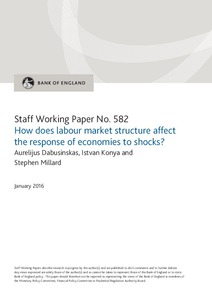How does labour market structure affect the response of economies to shocks?
"The recent crisis in the Eurozone has led to much discussion about the structure of labour markets in different Eurozone economies. In particular, there has been much talk of the need for structural labour market reform in the Eurozone periphery. But, there are many aspects of labour market st...
| Main Authors: | , , |
|---|---|
| Institution: | ETUI-European Trade Union Institute |
| Format: | TEXT |
| Language: | English |
| Published: |
London
2016
Bank of England |
| Subjects: | |
| Online Access: | https://www.labourline.org/KENTIKA-19106482124919246649-How-does-labour-market-structu.htm |
| Summary: | "The recent crisis in the Eurozone has led to much discussion about the structure of labour markets in different Eurozone economies. In particular, there has been much talk of the need for structural labour market reform in the Eurozone periphery. But, there are many aspects of labour market structure – eg, wage flexibility, flexibility in hiring and firing, generosity of welfare schemes, etc — and it is not clear a priori which aspects really matter. In this paper, we analyse how cross-country differences in labour market characteristics — in particular, wage and employment rigidities — shape the response of different countries to a variety of macroeconomic shocks. To address this question, we use a calibrated small open economy model in which we set the parameters governing the structural characteristics of the labour market based on three European countries: Estonia, Finland and Spain. We find that, given our labour market calibrations, we would expect output and unemployment to be much more adversely affected by the shocks associated with the financial crisis in countries with high job turnover rates." |
|---|---|
| Physical Description: | 22 p. Digital |

